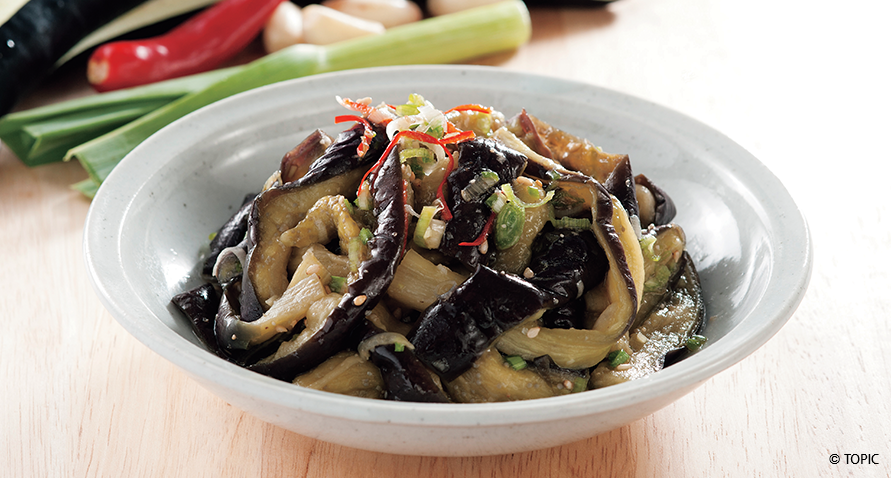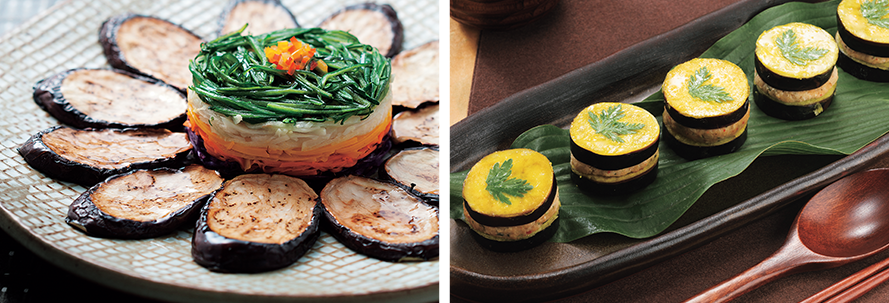Eggplant is a popular summer vegetable. Its appeal is reflected in the old Korean saying, “The eggplant offers edible joy to endure the rainy season.” Perhaps people feel more confident about surviving the hot summer by eating the cool purple vegetable chock-full of anthocyanins that have many health benefits.
“Cooking is one of the oldest arts.” This statement by French gastronome Jean Anthelme Brillat-Savarin contains deep insight. The way certain food ingredients are cooked clearly reveals the characteristics and history of a people’s food culture. Conversely, it can be said that the longer the history of a food ingredient, the greater the variety in the ways it is cooked.
For example, let’s compare eggplants and tomatoes, both of which belong to the Solanaceae family. The leaves and flowers of plants in this family, also called nightshades, cannot be eaten because they contain alkaloids for self-protection; thus, what we eat is their fruits.
But very seldom are tomatoes served as a side dish on Korean dining tables. While most countries treat the tomato as a vegetable, Koreans consider it a fruit. Except for pickled green tomatoes, tomatoes are mostly consumed as a dessert or beverage ingredient. By contrast, Koreans treat the eggplant as a vegetable and eat it as a side dish with rice, like radishes, Chinese cabbage or zucchini.
Eggplant is often steamed on its own or on top of rice. The hot, steamed eggplants are torn into strips with the hands, first dipped in cold water to prevent them from getting burned. The strips are mixed with sliced green chili, soy sauce, sesame oil and toasted sesame seeds. This cooking method was introduced in the Dong-a Ilbo newspaper on August 4, 1931. The same article included a few other cooking methods, such as drying the eggplants in July and August when they are abundant and eating them during the winter, soaked first in water and then seasoned, as well as lightly salting thin slices of raw eggplant, letting them stand for a while and then mixing them with mustard and assorted garnishes.
Enjoyed Cooked and Raw
In Korea, eggplant has been prepared in many ways over the ages and remains a popular side dish. One way is to cut eggplants into bite-sized pieces, lightly coat them with flour, deep-fry and finally season them. Another way is to make fritters by covering thin slices of eggplant with minced beef, coating them with egg, and frying them in a pan. With increased overseas travel and contact with people from other countries, more Koreans are trying their hand at foreign eggplant dishes, such as Chinese yuxiang qiezi (fish-fragrant eggplant), Japanese nasu dengaku (miso-glazed eggplant) and Italian parmigiana di melanzane (eggplant parmesan).
Although both belong to the Solanaceae family, tomatoes and eggplants have completely different places in the dietary life of Koreans, probably due to the way they were introduced to the country. The tomato, originating in South America, arrived in Korea in the early 17th century but did not take on as a common food ingredient. It entered the Korean diet again in the early 20th century but has yet to be adapted for many dishes. By contrast, the eggplant, which originated in the Asiatic tropics, was introduced to Korea far earlier than the tomato from India via China. It has a long history as part of Korean cuisine; some sources say it was already grown on the peninsula over a thousand years ago during the Silla period.
In the subsequent Goryeo period, the eggplant seems to have become a popular food ingredient. In his poem “Gapo yugyeong” (“Song of Six Garden Vegetables”), Yi Gyu-bo (1168-1241) praised the taste and virtue of the eggplant as follows:
Glowing reddish purple,
how can it be thought old?
How can anything vie with
the eggplant’s flower and fruit?
Its fruit abounding within the furrow,
It is truly good,
both cooked and raw.
Some may find it surprising that eggplant can be eaten raw. But it is true. Koreans use raw eggplants to make kimchi or pickle them in soybean paste. In Thailand, raw green eggplants that resemble golf balls are eaten with a dipping sauce. Like other fruits belonging to the Solanaceae family, the eggplant contains the toxic alkaloid solanine, but in such small quantities that it is harmless unless 30 to 40 eggplants are consumed in one sitting.
Eggplant also contains nicotine, another characteristic of plants in the Solanaceae family. While nicotine contained in food is not destroyed by heat, the amount found in 10 kilograms of eggplant equals the amount in one cigarette. In any case, the nicotine has no effect because it is detoxicated in the liver upon entering the body and then quickly excreted.
As for wild eggplant, the bitter component helps to protect it against animals that would otherwise eat it, but from the perspective of humans it is poisonous. Considering the eggplant poisonous, the ancient Romans called it mala insana, meaning “crazy apple,” which is etymologically linked to melanzana, the Italian word for the eggplant. Judging from the 11th-century Bedouin saying, “Its color is like the scorpion’s belly, its taste is the scorpion’s poisonous sting,” the bitterness of eggplant seems to have been notorious for many centuries.
The eggplant, which originated in the Asiatic tropics, was introduced to Korea far earlier than the tomato from India via China. It has a long history as part of Korean cuisine; some sources say it was already grown on the peninsula over a thousand years ago during the Silla period.
Diverse Colors, Shapes and Sizes
However, today’s eggplants are far from the “crazy apple” of the past. Humankind has developed new cultivars of diverse colors, shapes and sizes through breeding and farming. As the result, an eggplant as small as a pea (Thai Pea Eggplant) has been produced as well as one that is up to 40 centimeters long (Japanese Pingtung Long Eggplant), a heavy kind reaching up to 650 grams (Black Enorma), as well as green, white and purple eggplants and even one with a striped pattern. A white, egg-shaped kind was widely grown in America for some time; hence the English name “eggplant.”
Meanwhile, those who disliked the bitter taste of the eggplant explored ways of reducing it. One method often mentioned in early cookbooks is to slice or cube the eggplant, sprinkle the pieces with coarse salt and let them sit for 30 minutes to an hour. The salt can reduce the moisture content, but it does not completely get rid of the bitter taste. Nevertheless, in the past, many cooks treated eggplant with salt because the saltiness covered the bitterness and improved the flavor. Today’s eggplants are less bitter, which makes this step unnecessary, but sprinkling salt over them is useful for other reasons.

Eggplant is mostly eaten in Korean homes as a side dish with rice. It is lightly steamed and torn into strips, and seasoned with a mixture of soy sauce, vinegar, chopped green onion, sesame oil, and toasted sesame seeds.

Eggplant is also used to make special dishes for guests or other occasions. It can be cut into thin slices and pan-fried in oil (left), or cut into thick slices and, with marinated minced beef sandwiched between them, coated with flour and egg batter, and panfried.
An Ingredient for a Thousand Dishes
Eggplant tissue is spongy, and the texture results in a special sweet flavor. However, when deep-fried or stir-fried, the air cells absorb a lot of oil, making the texture mushy. Sprinkling salt beforehand prevents this problem as salt draws water out of the cells and fills them. Turkish eggplant dishes and Sichuan-style Chinese eggplant dishes make use of this phenomenon to obtain soft, buttery textures.
In Southeast Asian regions, the bitter taste of eggplant is used to add flavor. One example is Thai green curry, which contains the bitter pea eggplant. In many countries, eggplant is consumed as a substitute for meat as well as sweet dessert dishes.
In Middle Eastern countries there is a saying, “A woman is not ready to marry until she knows a thousand ways to cook eggplant.” This means that eggplant can be prepared in numerous ways, which leads one to wonder, “How can you find any vegetable as tempting and appetizing as the purple eggplants glowing brilliantly under the hot summer sun?”
The eggplant’s skin, tinged purple, red and blue at the same time, contains an abundance of antioxidant anthocyanins. Like mysterious paint colors seeping through, these pigments are mostly contained in the eggplant’s skin at 700 milligrams per 100 grams, offering protection against damage caused by ultraviolet radiation. Argument remains over the rate of absorption of the anthocyanins in the human body - all the more reason to cook the glossy purple eggplant with the skin on to gain as much benefit as possible from this beloved food ingredient.